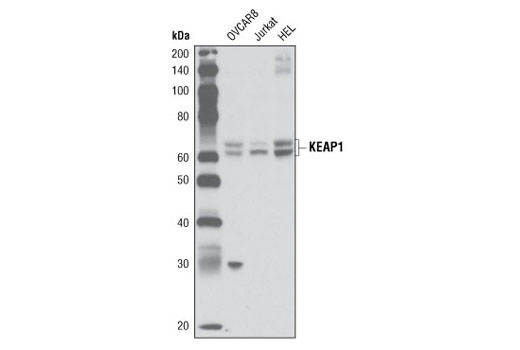WB, IP
H M R
Endogenous
60-64
Rabbit
#Q14145
9817
Product Information
Product Usage Information
| Application | Dilution |
|---|---|
| Western Blotting | 1:1000 |
| Immunoprecipitation | 1:50 |
Storage
Specificity / Sensitivity
Species Reactivity:
Human, Mouse, Rat
Source / Purification
Polyclonal antibodies are produced by immunizing animals with a synthetic peptide corresponding to residues surrounding Pro586 of human KEAP1 protein. Antibodies were purified by protein A and peptide affinity chromatography.
Background
The nuclear factor-like 2 (NRF2) transcriptional activator binds antioxidant response elements (ARE) of target gene promoter regions to regulate expression of oxidative stress response genes. Under basal conditions, the NRF2 inhibitor INrf2 (also called KEAP1) binds and retains NRF2 in the cytoplasm where it can be targeted for ubiquitin-mediated degradation (1). Small amounts of constitutive nuclear NRF2 maintain cellular homeostasis through regulation of basal expression of antioxidant response genes. Following oxidative or electrophilic stress, KEAP1 releases NRF2, thereby allowing the activator to translocate to the nucleus and bind to ARE-containing genes (2). The coordinated action of NRF2 and other transcription factors mediates the response to oxidative stress (3). Altered expression of NRF2 is associated with chronic obstructive pulmonary disease (COPD) (4). NRF2 activity in lung cancer cell lines directly correlates with cell proliferation rates, and inhibition of NRF2 expression by siRNA enhances anti-cancer drug-induced apoptosis (5).
The NRF2 repressor KEAP1 contains an amino terminal BTB/POZ domain and a carboxyl terminal KELCH domain (6,7). The KELCH domain is required for interacting with NRF2 and the BTB/POZ domain functions in binding Cul3 E3 ubiquitin ligase (8-10). Under normal conditions, the complex leads to the cytoplasmic sequestration and ubiquitin-mediated proteasomal degradation of NRF2. Electrophilic modification of KEAP1 leads to disassociation of the NRF2/KEAP1 complex. KEAP1 also targets the down regulation of NF-κB activity by targeting IKKβ degradation (11). Mutation of the corresponding KEAP1 gene is seen in lung cancer cases and can lead to uncontrolled activation of NRF2 (12-14).
- Cullinan, S.B. et al. (2004) Mol Cell Biol 24, 8477-86.
- Nguyen, T. et al. (2005) J Biol Chem 280, 32485-92.
- Jaiswal, A.K. (2004) Free Radic Biol Med 36, 1199-207.
- Suzuki, M. et al. (2008) Am J Respir Cell Mol Biol 39, 673-82.
- Homma, S. et al. (2009) Clin Cancer Res 15, 3423-32.
- Itoh, K. et al. (1999) Genes Dev 13, 76-86.
- Dhakshinamoorthy, S. and Jaiswal, A.K. (2001) Oncogene 20, 3906-17.
- Furukawa, M. and Xiong, Y. (2005) Mol Cell Biol 25, 162-71.
- Zhang, D.D. et al. (2004) Mol Cell Biol 24, 10941-53.
- Kobayashi, A. et al. (2004) Mol Cell Biol 24, 7130-9.
- Lee, D.F. et al. (2009) Mol Cell 36, 131-40.
- Padmanabhan, B. et al. (2006) Mol Cell 21, 689-700.
- Singh, A. et al. (2006) PLoS Med 3, e420.
- Ohta, T. et al. (2008) Cancer Res 68, 1303-9.
Species Reactivity
Species reactivity is determined by testing in at least one approved application (e.g., western blot).
Western Blot Buffer
IMPORTANT: For western blots, incubate membrane with diluted primary antibody in 5% w/v BSA, 1X TBS, 0.1% Tween® 20 at 4°C with gentle shaking, overnight.
Applications Key
WB: Western Blotting IP: Immunoprecipitation
Cross-Reactivity Key
H: human M: mouse R: rat Hm: hamster Mk: monkey Vir: virus Mi: mink C: chicken Dm: D. melanogaster X: Xenopus Z: zebrafish B: bovine Dg: dog Pg: pig Sc: S. cerevisiae Ce: C. elegans Hr: horse GP: Guinea Pig Rab: rabbit All: all species expected
Trademarks and Patents
Limited Uses
Except as otherwise expressly agreed in a writing signed by a legally authorized representative of CST, the following terms apply to Products provided by CST, its affiliates or its distributors. Any Customer's terms and conditions that are in addition to, or different from, those contained herein, unless separately accepted in writing by a legally authorized representative of CST, are rejected and are of no force or effect.
Products are labeled with For Research Use Only or a similar labeling statement and have not been approved, cleared, or licensed by the FDA or other regulatory foreign or domestic entity, for any purpose. Customer shall not use any Product for any diagnostic or therapeutic purpose, or otherwise in any manner that conflicts with its labeling statement. Products sold or licensed by CST are provided for Customer as the end-user and solely for research and development uses. Any use of Product for diagnostic, prophylactic or therapeutic purposes, or any purchase of Product for resale (alone or as a component) or other commercial purpose, requires a separate license from CST. Customer shall (a) not sell, license, loan, donate or otherwise transfer or make available any Product to any third party, whether alone or in combination with other materials, or use the Products to manufacture any commercial products, (b) not copy, modify, reverse engineer, decompile, disassemble or otherwise attempt to discover the underlying structure or technology of the Products, or use the Products for the purpose of developing any products or services that would compete with CST products or services, (c) not alter or remove from the Products any trademarks, trade names, logos, patent or copyright notices or markings, (d) use the Products solely in accordance with CST Product Terms of Sale and any applicable documentation, and (e) comply with any license, terms of service or similar agreement with respect to any third party products or services used by Customer in connection with the Products.

